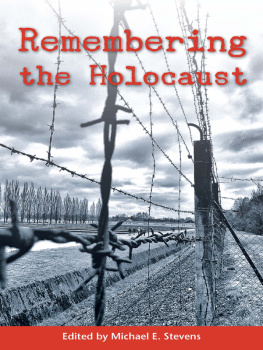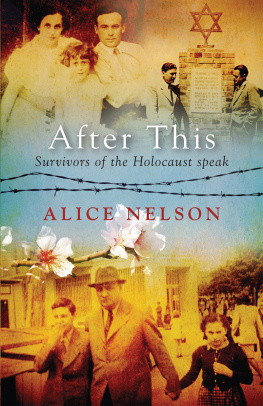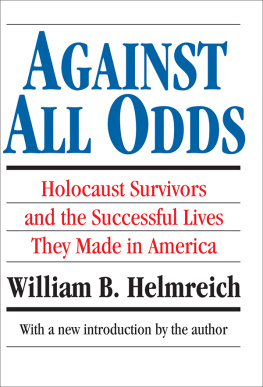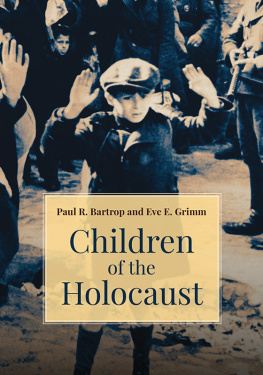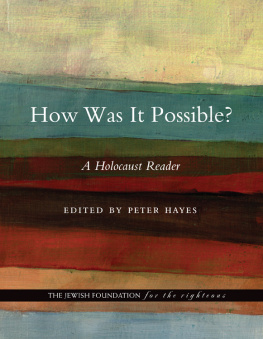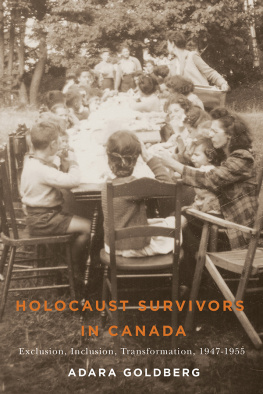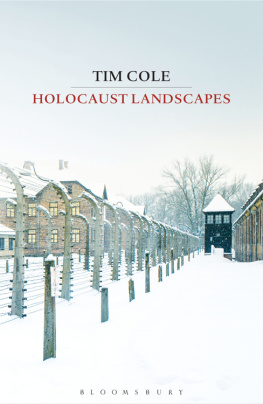Cover
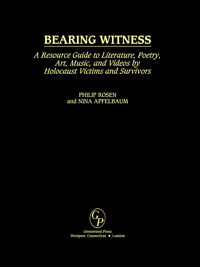
| title | : | Bearing Witness : A Resource Guide to Literature, Poetry, Art, Music, and Videos By Holocaust Victims and Survivors |
| author | : | Rosen, Philip.; Apfelbaum, Nina. |
| publisher | : | Greenwood Publishing Group |
| isbn10 | asin | : | 0313310769 |
| print isbn13 | : | 9780313310768 |
| ebook isbn13 | : | 9780313016592 |
| language | : | English |
| subject | Holocaust, Jewish (1939-1945)--Personal narratives--Bio-bibliography, Holocaust, Jewish (1939-1945), in literature--Bio-bibliography, Holocaust, Jewish (1939-1945), in art--Catalogs, Holocaust, Jewish (1939-1945)--Songs and music--Bibliography--Catalogs, |
| publication date | : | 2002 |
| lcc | : | D804.3ebR67 2002 |
| ddc | : | 016.94053/18 |
| subject | : | Holocaust, Jewish (1939-1945)--Personal narratives--Bio-bibliography, Holocaust, Jewish (1939-1945), in literature--Bio-bibliography, Holocaust, Jewish (1939-1945), in art--Catalogs, Holocaust, Jewish (1939-1945)--Songs and music--Bibliography--Catalogs, |
Page ii
Bearing Witness
Page iii
BEARING WITNESS
A Resource Guide to Literature, Poetry, Art, Music, and Videos by Holocaust Victims and Survivors
PHILIP ROSEN
and NINA APFELBAUM

Greenwood Press
Westport, Connecticut London
Page iv
Library of Congress Cataloging-in-Publication Data
Rosen, Philip.
Bearing witness : a resource guide to literature, poetry, art, music, and videos by
Holocaust victims and survivors / Philip Rosen and Nina Apfelbaum.
p. cm.
Includes bibliographical references (p.) and index.
ISBN 0313310769 (alk. paper)
1. Holocaust, Jewish (19391945)Personal narrativesBio-bibliography. 2.
Holocaust, Jewish (19391945), in literatureBio-bibliography. 3. Holocaust, Jewish
(19391945), in artCatalogs. 4. Holocaust, Jewish (19391945)Songs and
musicBibliographyCatalogs. 5. Holocaust, Jewish (19391945)Video catalogs. I.
Apfelbaum, Nina. II. Title.
Z6374.H6 R67 2002
[D804.3]
016.9405318dc21 00069153
British Library Cataloguing in Publication Data is available.
Copyright 2002 by Philip Rosen and Nina Apfelbaum
All rights reserved. No portion of this book may be
reproduced, by any process or technique, without
the express written consent of the publisher.
Library of Congress Catalog Card Number: 00069153
ISBN: 0-313-31076-9
First published in 2002
Greenwood Press, 88 Post Road West, Westport, CT 06881
An imprint of Greenwood Publishing Group, Inc.
www.greenwood.com
Printed in the United States of America

The paper used in this book complies with the
Permanent Paper Standard issued by the National
Information Standards Organization (Z39.481984).
10 9 8 7 6 5 4 3 2 1
Page v
This page intentionally left blank.
Page vi
Contents
Preface | vii |
Historical Background of the Holocaust | xi |
1 | Memoirs, Diaries, and Fiction of the Holocaust | 1 |
2 | Poetry of the Holocaust | 105 |
3 | Art of the Holocaust | 121 |
4 | Music of the Holocaust | 165 |
5 | Videos of the Holocaust Experience | 183 |
Index | 197 |
Page vii
Preface
The writers, artists, and musicians whose works are profiled in this resource guide were selected on the basis of a number of criteria. Each individual was a victim or a survivor under the Nazi heel or of the repression of an ally of the Nazisvictims and survivors of concentration camps and ghettos, members of partisan groups, those in hiding, Jews disguised as Christians, and other victims of Nazi persecution. We have attempted to provide entries representing a variety of firsthand experiences and responses. Only works by those who were thereeyewitnesses to Holocaust historyare included. Some works cited in this book are collections of testimony, narratives, fiction, art, or poetry; each narrative, poem, or artwork in the collection is a firsthand account or artistic interpretation by a victim or survivor of the Holocaust. We have attempted to include those writers and artists who have achieved a degree of international recognition such as writers Charlotte Delbo, Primo Levi, and Elie Wiesel; poets Nellie Sachs and Paul Celan; painters Norbert Troller and Leo Haas; and composers Viktor Ullmann and Herschel Glik. But this resource also includes the work of less well known, unsung, and unrecognized eyewitnesses to history whose literature or art will help the student and other interested people to gain firsthand knowledge of what it was like to be a victim of Nazi persecution in the Holocaust.
This resource spans the entire period of Nazi aggression and genocide, from the early days of Nazi consolidation of power in Germany to the end of World War II. The experiences of writers and artists from many countries are represented, including those of Gentiles who shared the same fate as Jews. The experience of the Jews of Poland, of whom 3 million were killed by the Nazis, is well represented. Works from a va
Page viii
riety of ghettos, especially the Warsaw Ghetto, and from concentration camps, particularly Auschwitz, are also well represented.
To put the literature, art, and music resources into context, an introductory essay describes briefly the historical background of the Nazi persecution and Holocaust. The resource guide is then organized into five chapters:
| Writers of memoirs, diaries, and fiction |
| Poets |
| Artists |
| Composers and musicians |
| Videos of the Holocaust experience |
Each chapter is organized alphabetically by entry, and within the entry alphabetically by title. Entries that fall into two categories are fully annotated in the main section to which they are appropriate and are crossreferenced in the other section.
Chapter 1, Writers, provides a brief overview of Holocaust writing. The entry on each writer contains the following elements: brief biography, including birth (and death) date(s), place of birth and family members, a short overview of the writers Holocaust experience, and in the case of survivors, their liberation and immediate postwar experience. This is followed by an annotated bibliography of recommended works, which includes complete bibliographic data, capsule description of the work, and age appropriateness. Age appropriateness was determined by the works content, its vocabulary and its complexity of concepts and sentences. In addition, educational materials that designate age appropriateness, such as the catalogues of the United States Holocaust Memorial Museum, Social Studies School Service, and the Anti-Defamation League, were utilized.
Next page



